Today I chatted with Dr. Sharon Deem.
Dr. Deem is a wildlife veterinarian and epidemiologist. She is board certified from the American College of Zoological Medicine with a professional focus on diseases shared between domestic animals, wildlife, and people, and the impact of environmental change and human interactions on the health of wildlife populations. Sharon has conducted conservation medicine projects in 30 countries around the world including health-monitoring program for gorillas in central Africa, health assessments of sea turtles in Africa and the Americas, health and ecological studies of maned wolves in Bolivia, health care of working elephants in Asia, and avian and giant tortoise studies in the Galapagos Islands, Ecuador. Sharon is currently the director of the Saint Louis Zoo Institute for Conservation Medicine.
In this episode we will talk about One Health that is «Â a rolling movement, an initiative where many different disciplines come together to optimize the health of human and non-human animals, plants and the environment that sustained us. » People start to realize that «We are all connected: our health is dependent on animal health. » The great thing about One Health is that it is « all about finding solutions.
Dr. Deem will walk us through some projects she worked or is working on to illustrate the power of One Health.
«Deciding to preserve our planet is everyone’s matter: Yes! One person does matter»
It is the time to « use your voice and amplify it », this is our opportunity to listen, understand and take action, « be part of the solution »
Hope you enjoy the travel.

To know more about Dr. Deem fantastic work: go to the following links or selected papers below.
https://www.stlzoo.org/conservation/institute-for-conservation-medicine
Antimicrobial resistance in Galapagos tortoises as an indicator of the growing human footprint.
Nieto Claudin, A., Deem, S.L., RodrÃguez, C., Cano, S., Moity, N, Cabrera, F., and Esperón, F. 2021. Environmental Pollution 284 (10): 117453. 10.1016/j.envpol.2021.117453
Antimicrobial resistance has become one of the main public health threats worldwide with anthropogenic activities driving the spread of resistance. Understanding and combatting the spread of resistant bacteria is a top priority for global health institutions, and it is included as one of the main goals of the One Health initiative. Giant tortoises (Chelonoidis spp.), some of the most iconic species on Earth, are widely distributed across the Galapagos archipelago and are thus perfect candidates to test the hypothesis that wildlife species in the Galapagos carry antimicrobial resistant genes (ARGs) associated with human activities. We sampled a total of 200 free-living Galapagos tortoises from western Santa Cruz Island (C. porteri), the most human-populated island of the archipelago, and 70 tortoises (C. vandenburghi) from the isolated Alcedo Volcano on Isabela Island, a natural area with minimal human presence. Fecal samples were analyzed by quantitative PCR for a panel of 21 ARGs conferring resistance for eight antimicrobial classes. We found ARGs in both Santa Cruz and Alcedo Volcano giant tortoises; however, both qualitative and quantitative results showed higher loads of ARGs in tortoises inhabiting the human modified environments of Santa Cruz. Moreover, Santa Cruz tortoises sampled in higher human-modified landscapes (i.e., farmlands and urban areas) presented a higher number of ARGs, antimicrobial classes, and multi-resistant microbiomes than those from less anthropized areas within the same island. Our findings suggest that human activities in Galapagos have a negative impact on ecosystem health through ARG dispersal. This research highlights a new threat for the health and conservation of the unique wildlife of the Galapagos, their ecosystems, and the humans inhabiting this World Heritage Site. Our recommendation to local policy makers is to control and reduce the use of antibiotics in both human and animal health, thus helping enforce antimicrobial regulations.
Haematology and plasma biochemistry reference intervals for the critically endangered western Santa Cruz Galapagos tortoise (Chelonoidis porteri).
Nieto-Claudin, A., Palmer, J.L., Esperón, F., Deem, S.L. 2021. Journal of Conservation Physiology. 10.1093/conphys/coab019
Reference intervals (RIs) are an increasingly valuable tool for monitoring captive and free-living wildlife populations. Galapagos tortoises are one of the most emblematic species on Earth with 9 of the 12 extant species considered endangered due to human activities. As part of a long-term health assessment within the Galapagos Tortoise Movement Ecology Programme, we sampled a total of 210 free-living Santa Cruz Galapagos tortoises (Chelonoidis porteri). We collected blood from the brachial vein and performed packed cell volume (PCV), total solids (TS), morphological evaluation, white blood cell (WBC) count estimates and differentials and a VetScan biochemistry panel for each individual. We calculated 95% RIs and 90% confidence intervals (CIs) using the Reference Value Advisor tool and following international standard guidelines. Tortoises were categorized by estimated age and sex, with RI and CI reported here for 164 adult tortoises and 46 sub-adult tortoises. We found significant differences between sexes, with adult females presenting a lower PCV and higher values for both calcium and potassium. Among age groups, adult tortoises presented higher PCV, TS and albumin and lower WBC counts, aspartate aminotransferase and creatine kinase than sub-adult tortoises. We also found that tortoises presented higher numbers of lymphocytes during the dry season, but higher basophils, eosinophils, phosphorus, potassium and TS during the humid season. The heterophil:lymphocyte ratio did not differ between groups. To the authors’ knowledge, this is the first report of formal plasma biochemistry and haematology RI for free-living Galapagos tortoises. With the present study we provide an important diagnostic tool for captive-breeding programs in the Galapagos and zoological institutions globally that care for giant tortoises. The ultimate goal of this study is to contribute to the understanding of giant tortoise baseline health parameters and to inform local management decisions that help to conserve these emblematic species.
Field anesthesia of the maned wolf (Chrysocyon brachyurus) in Bolivia.
Bronson, E., Deem, S.L., Patino Westermann, L.C., Angulo Alpire, S., and Emmons, L.H. 2021. Journal of Wildlife Diseases. 57: https://doi.org/10.7589/JWD-D-20-00033
Fifteen maned wolves (Chrysocyon brachyurus) were anesthetized a total of 43 times as part of a long-term ecology and health study in a remote region of northeastern Bolivia. We administered tiletamine-zolazepam (TZ) to wolves in box traps or free-ranging, from blinds or on foot, at a mean dosage of 4.6 mg/kg intramuscularly. Detailed anesthetic information was recorded in 24 of these events in 11 wolves (six males, five females), and wolves were monitored closely post procedure with very high frequency or global positioning system telemetry collars. Anesthetic induction was smooth and rapid in all cases, with a mean 6.4 min from injection to recumbency. Vital parameters were stable during the majority of procedures. As expected with this drug combination, recovery was long (mean time to standing 163 min [range: 80-235 min]) but smooth, and animals were monitored in most cases in box traps until stable for release. One case of apnea and prolonged recovery is reported. In two cases, wolves recovered normally but were found to move minimally in the 2.5-4 d postprocedure before resuming normal movements. Overall, TZ provided safe, stable immobilization of free-ranging maned wolves in remote and extreme field conditions, although postanesthesia monitoring via telemetry is recommended.
Endogenization of a prosimian retrovirus during lemur evolution.
Apakupakul, K., Deem, S.L, Maqsood, R., Sithiyopasakul, P, Wang, D., and Lim, E.S. 2021. Viruses. 13, 383. https://doi.org/10.3390/v13030383
Studies of viruses that coevolved with lemurs provide an opportunity to understand the basal traits of primate viruses and provide an evolutionary context for host-virus interactions. Germline integration of endogenous retroviruses (ERVs) are fossil evidence of past infections. Hence, characterization of novel ERVs provides insight into the ancient precursors of extant viruses and the evolutionary history of their hosts. Here, we report the discovery of a novel endogenous retrovirus present in the genome of a lemur, Coquerel’s sifaka (Propithecus coquereli). Using next-generation sequencing, we identified and characterized the complete genome sequence of a retrovirus, named prosimian retrovirus 1 (PSRV1). Phylogenetic analyses indicate that PSRV1 is a gamma-type betaretrovirus basal to the other primate betaretroviruses and most closely related to simian retroviruses. Molecular clock analysis of PSRV1 long terminal repeat (LTR) sequences estimated the time of endogenization within 4.56 MYA (±2.4 MYA), placing it after the divergence of Propithecus species. These results indicate that PSRV1 is an important milestone of lemur evolution during the radiation of the Propithecus genus. These findings may have implications for both human and animal health in that the acquisition of a gamma-type env gene within an endogenized betaretrovirus could facilitate a cross-species jump between vertebrate class hosts.
Biodiversity and Human Health Interlinkages in Higher Education offerings: A first global overview.
Cianfagna,M., Bolon, I., Babo Martins, S., Mumford, E., Romanelli, C., Deem, S., Pettan-Brewer, C., Figueroa, D., Velasquez, J., Stroud, C., Lueddeke, G., Stoll, B., Ruiz De Castañeda, R. 2021. Frontiers in Public Health. https://www.frontiersin.org/articles/10.3389/fpubh.2021.637901/full
Introduction: Biodiversity is inextricably linked to human health. As an important area of research of the Convention on Biological Diversity and a key avenue for the dissemination of biodiversity and health knowledge, we investigated how well-embedded biodiversity and health interlinkages are in institutional higher education offerings. Methods: Using One Health education programs as a starting point, we collected a global list of institutions potentially carrying out education in the links between biodiversity and health through previously published research, academic partners of global conglomerates, and our own networks. We then analyzed the offerings from these institutions to determine the degree of integration of biodiversity and health interlinkages. Results: We found 105 educational offerings in biodiversity and health interlinkages from 89 institutions in 30 countries. These were primarily found in faculties of public health, veterinary sciences, and medicine, with varying degrees of coverage of the interlinkages. Conclusion: Education incorporating the links between biodiversity and health exists globally, but should be more widely integrated, particularly through inter-faculty and inter-institutional collaboration.
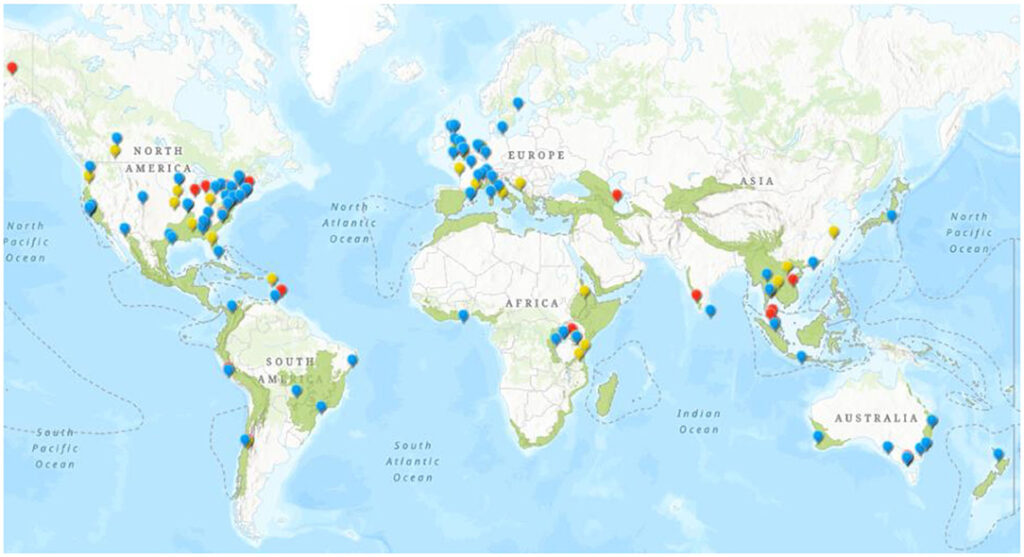
Individual, household and environmental factors associated with arboviruses in rural human populations, Brazil.
Catenacci, L.S., Ferreira, M.S., Fernandes, D., Padda, H., Travassos-da-Rosa, E.S., Deem, S.L., Vasconcelos, P.F.C., and Martins, L.C. 2020. Zoonoses and Public Health. https://doi.org/10.1111/zph.12811.
Landscape change is one of the foremost drivers of the emergence of infectious diseases. Exploring demographic, household and environmental conditions under which infectious diseases occur may inform strategies to prevent disease emergence in human populations. We collected blood samples from 523 humans and explore factors for arbovirus emergence in Bahia, Brazil. The overall arbovirus seroprevalence was 65.2%, with the genus Flavivirus most prevalent (64.4%). Based on monotypic reactions, the population had contact with five arbovirus: Dengue 3, Ilheus, Oropouche, Caraparu and Eastern equine encephalitis virus. To our knowledge, this is the first study reporting exposure to Oropouche, Caraparu and Eastern equine encephalitis virus in human populations in Bahia, Northeast of Brazil. The best model fit demonstrated that household and environmental variables were more predictive of the risk of arbovirus exposure than demographic variables. The presence of forest and free-living monkeys in the areas close to the communities had a protective effect for the human population (i.e. lower seroprevalence). The dilution effect is considered as one explanation for this finding. These results highlight the important ecological role of wildlife-friendly agriculture.
Field anesthesia and gonadal morphology of immature western Santa Cruz tortoises (Chelonoidis poteri).
Emmel, E.S., Rivera, S., Cabrera, F., Blake, S., and Deem, S.L. 2020. Journal of Zoo and Wildlife Medicine. 51. 848-855.
Evaluation of sex ratios is a critical component of chelonian captive breeding programs and may become increasingly useful to assess the demographics of free-living populations. In many reptile species, the sex of immature animals cannot be determined based on external features. Endoscopic sex identification is an accurate and safe method to identify the sex of immature individuals of some chelonian species. A number of studies describe this technique in controlled, hospital settings and report significant interspecies variations in gonad morphology; however, there are few reports describing this technique in field conditions. In the current study, the gonadal morphology of 40 immature Western Santa Cruz tortoises (Chelonoidis porteri) on Santa Cruz Island in Galapagos, Ecuador, was assessed. A previously described endoscopic protocol was used to perform sex identification under field conditions. Tortoises were anesthetized using an intramuscular injection of ketamine (10 mg/kg) and medetomidine (0.1 mg/kg), which provided an adequate plane of anesthesia. The medetomidine was reversed with atipamezole (0.5 mg/kg). Field conditions presented challenges such as limited control over lighting, suboptimal patient positioning, and restricted power supply for endoscopy equipment. The immature testicle in Western Santa Cruz tortoises was oval, reddish pink, and tightly adhered to the coelomic membrane ventral to the kidney. The surface of the gonads resembled other species with the notable exception that the ovaries lacked a significant number of primordial follicles. These gonadal characteristics were consistent, with only one individual identified as undetermined sex of the 40 samples. This field-based endoscopic gonadal evaluation was a safe and sensitive technique for determining the sex of free-living immature Western Santa Cruz Galapagos tortoises.
One Health – the Key to Preventing COVID-19 from Becoming the New Normal.
Deem, S.L., and Brenn-White, M. 2020. Molecular Frontiers Journal. https://www.worldscientific.com/doi/pdf/10.1142/S2529732520400039
While we experience the most significant zoonotic pandemic in 100 years, we would do well to consider how we arrived at this historic moment and how we will prevent the next pandemic. In this commentary, we explore the human drivers of emerging infectious diseases and contend that a One Health approach-in which multiple disciplines work together to ensure the health of environments, humans, and non-human animals-is imperative to get through this pandemic and to prevent future ones.
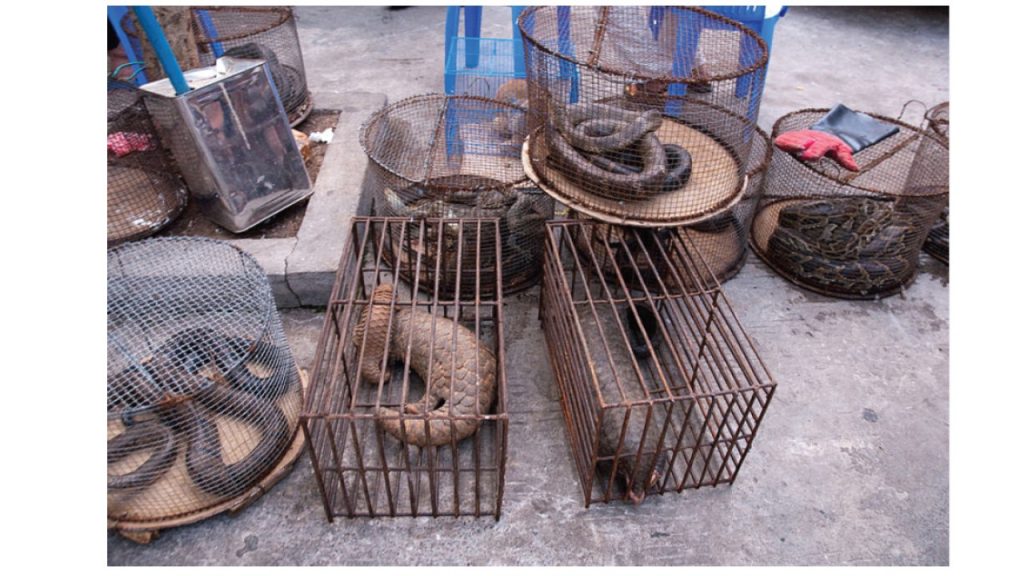
Myanmar, are prime sites for spillover of zoonotic pathogens between human and non-human animals. ©Dan Bennett/Wikimedia
Commons/CC-BY-2.0/https://commons.wikimedia.org/wiki/File:Myanmar_Illicit_Endangered_Wildlife_Market_04.jpg
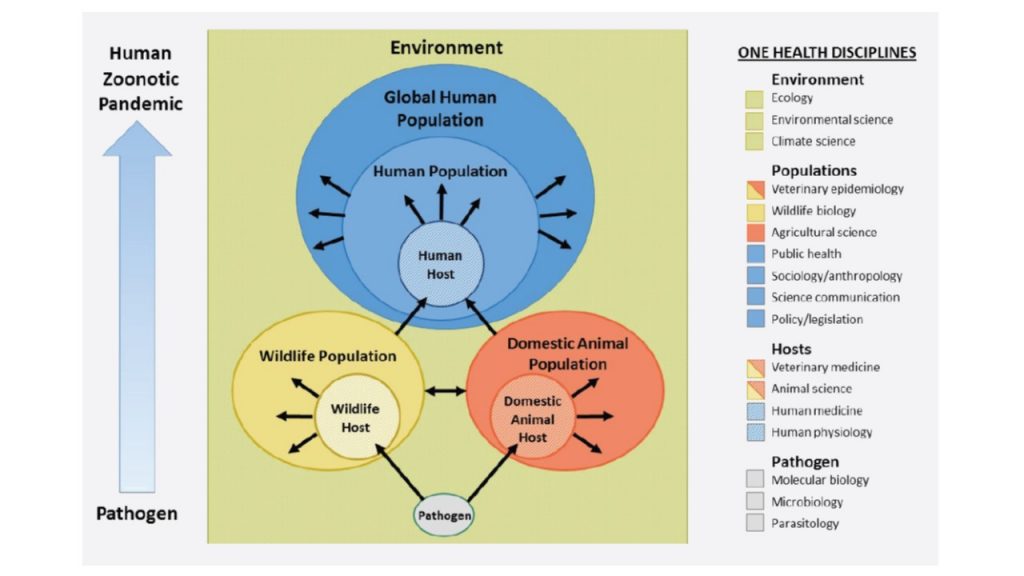
multiple arrows indicate spread of pathogens from the initially infected host to multiple hosts through multiple transmission events; colors and patterns
in the boxes adjacent to discipline names correspond to specific aspects of the pathway that each discipline typically works within.
Conservation medicine and One Health in zoos: Scope, obstacles, and unrecognized potential.
Sulzner K., Fiorello C., Ridgley F., Garelle D., and Deem S.L. Zoo Biology. 2020;1-8. https://doi.org/10.1002/zoo.21572
One Health disciplines along the pathway from pathogen to human zoonotic pandemic. Arrows indicate pathogen movement or transmission; multiple arrows indicate spread of pathogens from the initially infected host to multiple hosts through multiple transmission events; colors and patterns in the boxes adjacent to discipline names correspond to specific aspects of the pathway that each discipline typically works within.
Deem, S.L. 2020. A Time of Great Opportunity – One Health in the Age of Climate Change, Extinctions, and a Pandemic. WAZA magazine.
Changes in human health parameters associated with an immersive exhibit experience at a zoological institution.
Coolman, A.A., Niedbalski, A., Powell, D.M., Kozlowski, C.P., Franklin, A.D., and Deem, S. L. 2020. PlosOne. https://journals.plos.org/plosone/article/authors?id=10.1371/journal.pone.0231383
Zoological institutions often use immersive, naturalistic exhibits to create an inclusive atmosphere that is inviting for visitors while providing for the welfare of animals in their collections. In this study, we investigated physiological changes in salivary cortisol and blood pressure, as well as psychological changes among visitors before and after a walk through the River’s Edge, an immersive, naturalistic exhibit at the Saint Louis Zoo. Study participants had a significant reduction in salivary cortisol and blood pressure after walking through the exhibit. Psychological assessments of mood found that most visitors felt happier, more energized, and less tense after the visit. Additionally, participants who spent more time in River’s Edge, had visited River’s Edge prior to the study, and had seen more exhibits at the Zoo prior to entering River’s Edge experienced greater psychological and/or physiological benefits. We conclude that immersive, naturalistic exhibits in zoos can elicit positive changes in physiological and psychological measures of health and well-being and argue for a greater scientific focus on the role of zoos and other green spaces in human health.

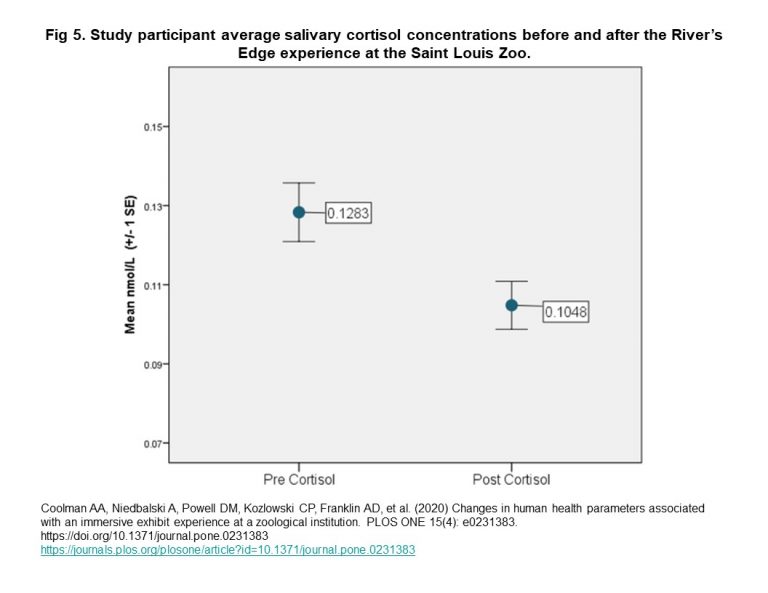

Mortality of Three-Toed Box Turtles (Terrapene mexicana triunguis) at two sites in Missouri.
Palmer, J.L., Brenn-White, M., Blake, S., and Deem, S.L. 2019. Frontiers in Veterinary Science. https://doi.org/10.3389/fvets.2019.00412
Once ubiquitous, North American box turtles are experiencing reductions in abundance and range, but the magnitude of these losses is largely unknown. In Missouri, native box turtles (Terrapene mexicana triunguis and Terrapene ornata ornata) are declining across the state due to anthropogenic disturbances such as urbanization, habitat fragmentation, and vehicle collisions. Through radio-tracking over a period of 7 years, we documented the survival of adult three-toed box turtles at two sites in Missouri: Forest Park (urban park) and Tyson Research Center (TRC) (a protected rural forest). Estimated annual survival of adult turtles in Forest Park was 79% (95% CI: 0.68-0.87) while at TRC annual survival was 93% (95% CI: 0.83-0.97). The odds of annual survival for a turtle at TRC were 3.5 times that of a turtle living in Forest Park. «Winter kill, » which refers to box turtles found dead on the surface during brumation or within 2 weeks of emergence, was the most frequently documented category of mortality in Forest Park. At TRC, winter kill was not documented; however, the reasons for most deaths were unknown. These data raise questions about the potential of large urban parks as refuges for box turtles, which we may answer by future studies that compare box turtles living in multiple urban and rural settings. Our preliminary data suggest that even the largest urban parks may not be able to sustain populations of box turtles which has severe implications as urbanization continues to degrade and eliminate box turtle habitat throughout their range.
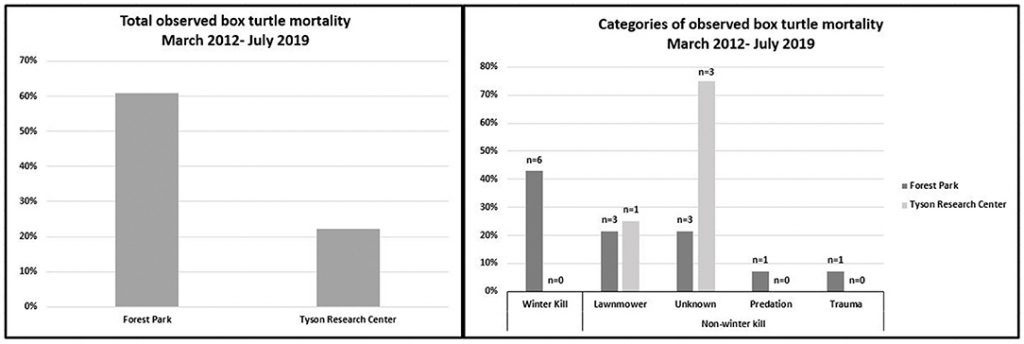
Deem, S.L., Lane-deGraaf, K., and Rayhel, E. 2019. Introduction to One Health: An Interdisciplinary Approach to Planetary Health. Wiley-Blackwell. Hoboken, NJ. Pp. 296.
A Review of Zoonotic Pathogens of Dromedary Camels.
Zhu, S., Zimmerman, D., and Deem, S.L. 2019. EcoHealth. https://doi.org/10.1007/s10393-019-01413-7.
Dromedary, or one-humped, camels Camelus dromedarius are an almost exclusively domesticated species that are common in arid areas as both beasts of burden and production animals for meat and milk. Currently, there are approximately 30 million dromedary camels, with highest numbers in Africa and the Middle East. The hardiness of camels in arid regions has made humans more dependent on them, especially as a stable protein source. Camels also carry and may transmit disease-causing agents to humans and other animals. The ability for camels to act as a point source or vector for disease is a concern due to increasing human demands for meat, lack of biosafety and biosecurity protocols in many regions, and a growth in the interface with wildlife as camel herds become sympatric with non-domestic species. We conducted a literature review of camel-borne zoonotic diseases and found that the majority of publications (65%) focused on Middle East respiratory syndrome (MERS), brucellosis, Echinococcus granulosus, and Rift Valley fever. The high fatality from MERS outbreaks during 2012-2016 elicited an immediate response from the research community as demonstrated by a surge of MERS-related publications. However, we contend that other camel-borne diseases such as Yersinia pestis, Coxiella burnetii, and Crimean-Congo hemorrhagic fever are just as important to include in surveillance efforts. Camel populations, particularly in sub-Saharan Africa, are increasing exponentially in response to prolonged droughts, and thus, the risk of zoonoses increases as well. In this review, we provide an overview of the major zoonotic diseases present in dromedary camels, their risk to humans, and recommendations to minimize spillover events..
